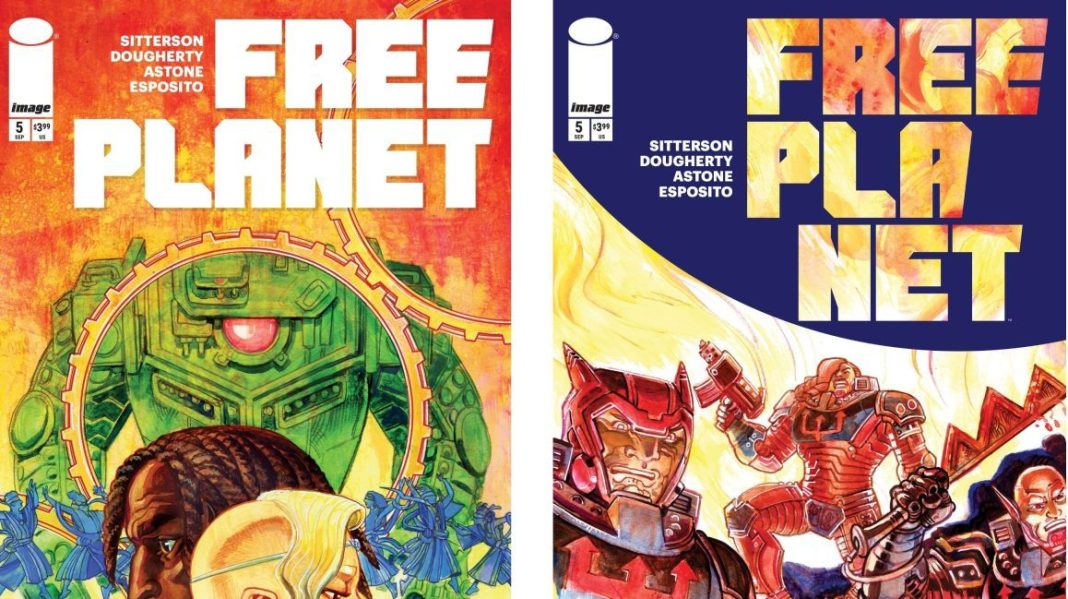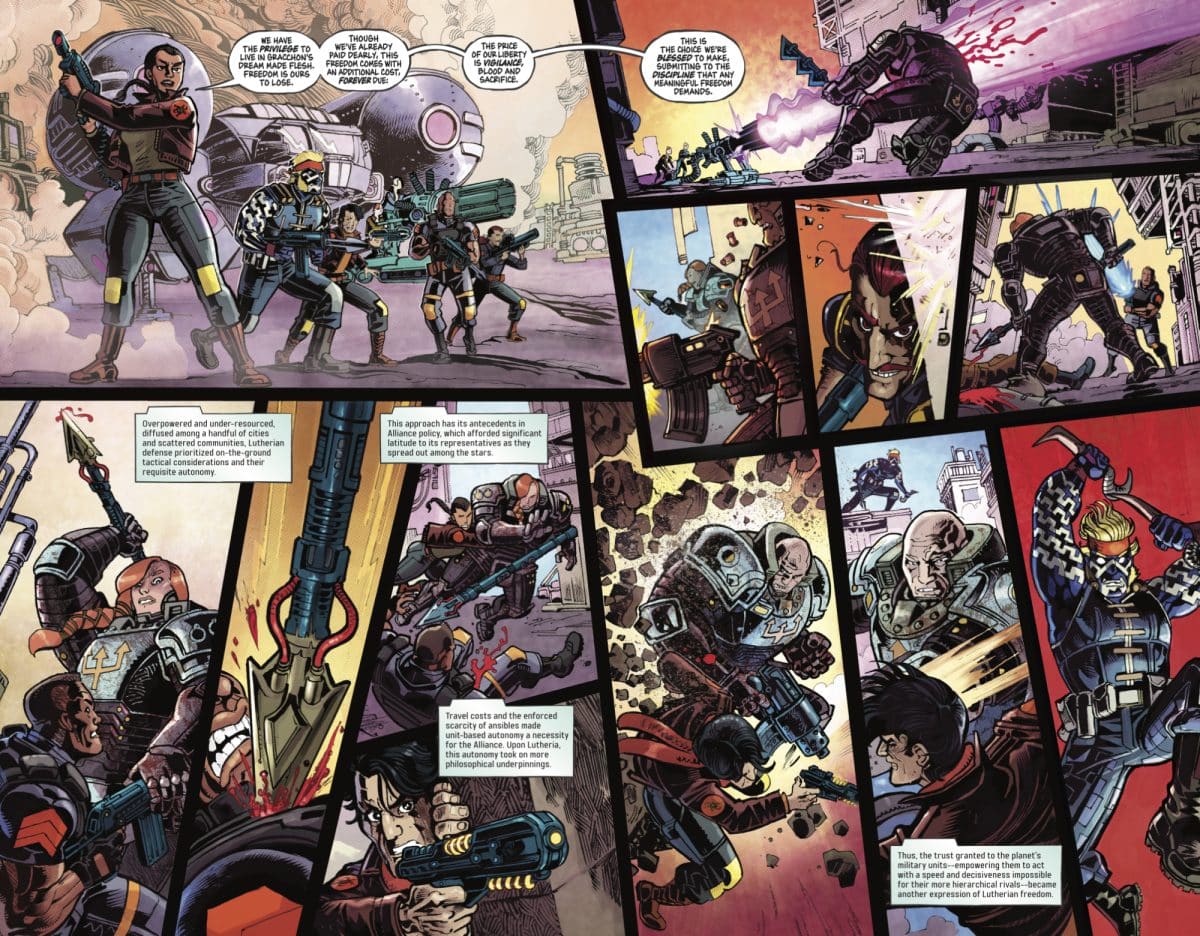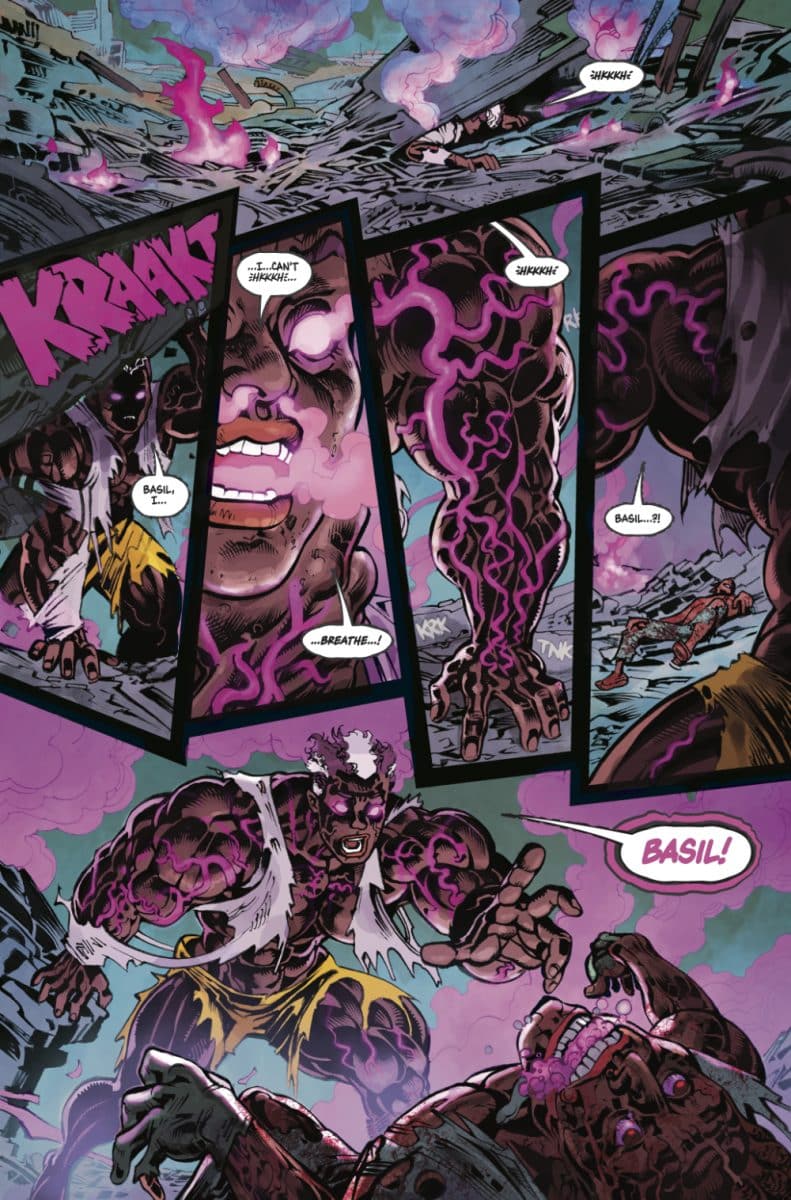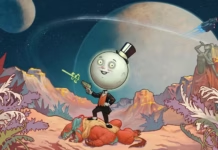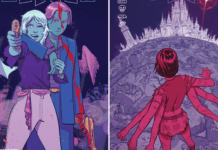Free Planet, by writer Aubrey Sitterson and artist Jed Dougherty, is a space epic that has a bit of everything: action, romance, and an expansive story that focuses on Lutheria, a planet that has recently gained its freedom, and the Freedom Guard trying to keep this new democracy alive.
Sitterson and Dougherty caught up with The Beat to talk about how Free Planet is a new approach to comics, not just story-wise but also visually, and the upcoming Free Planet #5 out in comic stores this September 10.
This interview was edited.

AUBREY SITTERSON: Free Planet started from a place of Jed and I wanting to do something more challenging – for us as well as readers – something rich and complex, that functions as both literature and art object. Everything else, from characters to setting to plot, grew out of that desire, my exhaustive and exhausting research into real-world revolutions, and Jed’s extensive design work, with all three feeding into one another.
JED DOUGHERTY: Yes, there is a ton of prep work.
From my end, it started with character design, since the heart of the book is distinctive characters striking sparks off one another. Aubrey wrote up a list of character archetypes he wanted to include, and I cooked up sketches that we bounced back and forth, refining the folks who would become our main cast. Next was designing the world of Lutheria; its unique geographical features, the technology of the extraction workers, and the retrofitted war-machines of the revolution. It’s been a years-long journey made in single steps, essentially.
Every issue, I read through the scripts to note all the new stuff that Aubrey mentions and at least sketch out a rough idea of each item, setting, or character.
Theoretically, every costume, tool, and vehicle is the product of a far future civilization from many different worlds. But in the interest of maintaining an identifiable relatability for readers, I have kept some stuff like the Freedom Guard uniforms pretty similar to modern clothing.
PEREZ: This is not a quick read; it feels like a historical document. It’s a book that expects the reader to hold on for a wild ride and return to some issues. How are fans reacting to it?
SITTERSON: What you’re describing – Free Planet requiring a slow, deliberate read – was also intentional, part and parcel with our goal of mapping out the shape of comics to come. Despite being such a unique book, very much at odds with the de rigueur comics approach, Free Planet has received an outspokenly warm reception; it’s clear that people are ready for a book that deeply engages with the form, attempting something inclusive of but beyond mere genre mash-ups and teleplay pacing.
The clearest example of this is our letters page, comprising detailed, thoughtful questions from readers about the broader universe in which the story takes place, and responses from our in-world historian, Dr. Aldous Foyroushi.
PEREZ: There is a lot of visual storytelling. Did you find that to be a necessity because the story was so rich in detail? Or is this the approach and tone of the book?
DOUGHERTY: We are trying to present a lot of information, and sometimes that is best served by captions, sometimes by charts, sometimes by having characters earnestly declare their intentions while shooting at each other.
SITTERSON: At the risk of being evasive, the answer is a hearty, “Both!” What I refer to as THE APPROACH – prioritizing page layout and the creation of nigh-overwhelming visual experiences in my pre-script thumbnails – has as its end goal the rich display of visual information; it’s our intent to push the medium to its breaking point, using all of the many tools that comics creators have at their disposal.
PEREZ: It’s a bit hard to summarize the book because it’s a space opera, but there is economics, religion, the growth of a new government, and choosing what it wants to become, action…there is a lot. What are some concepts and themes that people should keep in mind?
SITTERSON: It’s right there in the name: Free Planet is about freedom, what it entails, what we’re willing to sacrifice for it, the discipline it requires, and the authority that must arise in its absence. All of the geopolitical maneuvering, the big sci-fi military action, and the heated interpersonal drama feed into one another and off of these thematic preoccupations.
PEREZ: I’m finding that Excerpts and Q and As are necessary reading to really appreciate the next issue. How fun is it to write that in character?
SITTERSON: I’m so thrilled people are engaging with the backmatter and letters pages because you’re right: They’re far from extraneous; they’re essential components of the larger narrative. What’s more, they’re an absolute treat to write; the first is an opportunity to dig into aspects of the world that aren’t quite visual enough for inclusion in comics form, and the second is a chance for our most thoughtful readers to join us in a worldbuilding exercise.
Still, we’ve taken pains to ensure that, whether you’re ravenously devouring every single word, primarily focusing on the word balloons and action, or somewhere in between, Free Planet remains a compelling story, one that rewards you in proportion to your willingness to engage with it.
PEREZ: How fun was issue #3 to make? It was the kind of experience that made me think, “Oh yeah, that’s why I love comic books.” What was the process of doing that space fight, and what was Jed’s input on the layout of the book?
DOUGHERTY: The barrel-roll was Aubrey’s idea, running the book through a 360-degree rotation in reading orientation to reflect the dizzying motion of the dogfight. It was a lot of fun to draw and figure out the eye-tracking.
SITTERSON: Cerebus is my favorite comic of all time, and I often think of Sim’s formal approach, inclusive of comics that necessitate rotation. It strikes me as the exact type of technique at which comics excels; something that doesn’t work in any other medium or in digital comics. I started with very rough thumbnails, which fed into my scripts, trying to stick to two big images and a few insets for each spread. As ever, the real magic occurred once Jed dug into the pages, coming up with myriad ways to help guide the reader through the spin without ever losing them.
PEREZ: Issue 4 has a violent uprising on the planet of Lutheria, and the strength of the new government is being tested. What can fans look forward to in issue 5?
DOUGHERTY: Imperial incursions, industrial accidents, budding romances, and a big dance number!
SITTERSON: Every issue of Free Planet has at least one massive action set piece that – in addition to giving Jed a chance to shine – also provides the thematic foundations for the issue. In #5, the Orouran Empire strikes again, landing their space marines on the surface of Lutheria, leading to a daring defense from the Freedom Guard. Plus, our patient fans will finally get to learn the shocking origin stories of the team’s medical and science officers, including why the first is jacked to the gills and the second is encased in a massive metal body.
PEREZ: Anything you would like to add?
DOUGHERTY: Thank you to everybody who is reading our book!
SITTERSON: And thank you to the many readers and comic book shop owners who have not only taken a chance on a new ongoing comic that’s as unique as FREE PLANET but have continued to spread the good word. In 2025, word of mouth is more important than ever, and it’s what’s going to keep Free Planet hitting monthly for years to come.
Free Planet #5 published by Image Comics is out in comic stores as of September 10, 2025.


